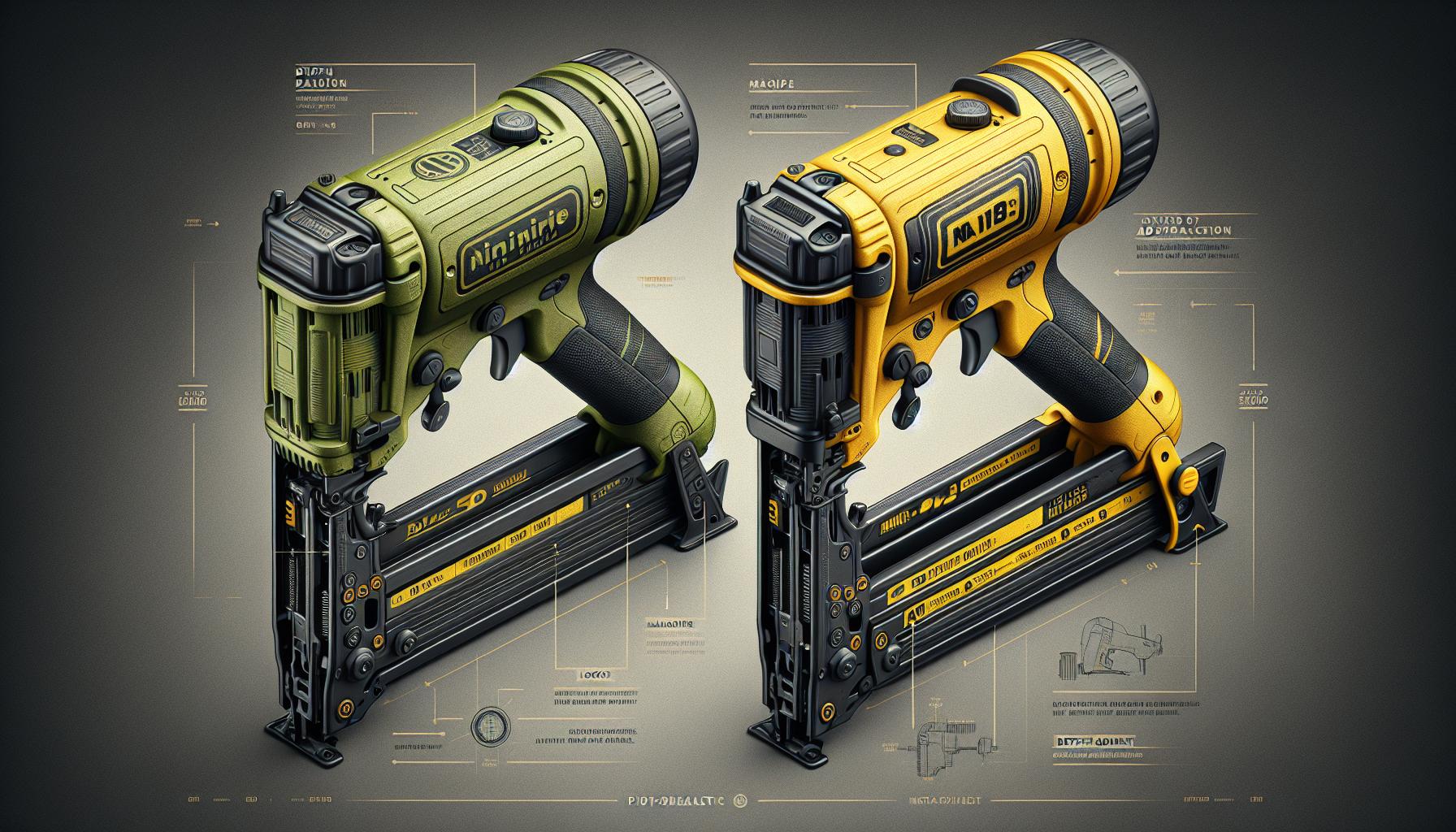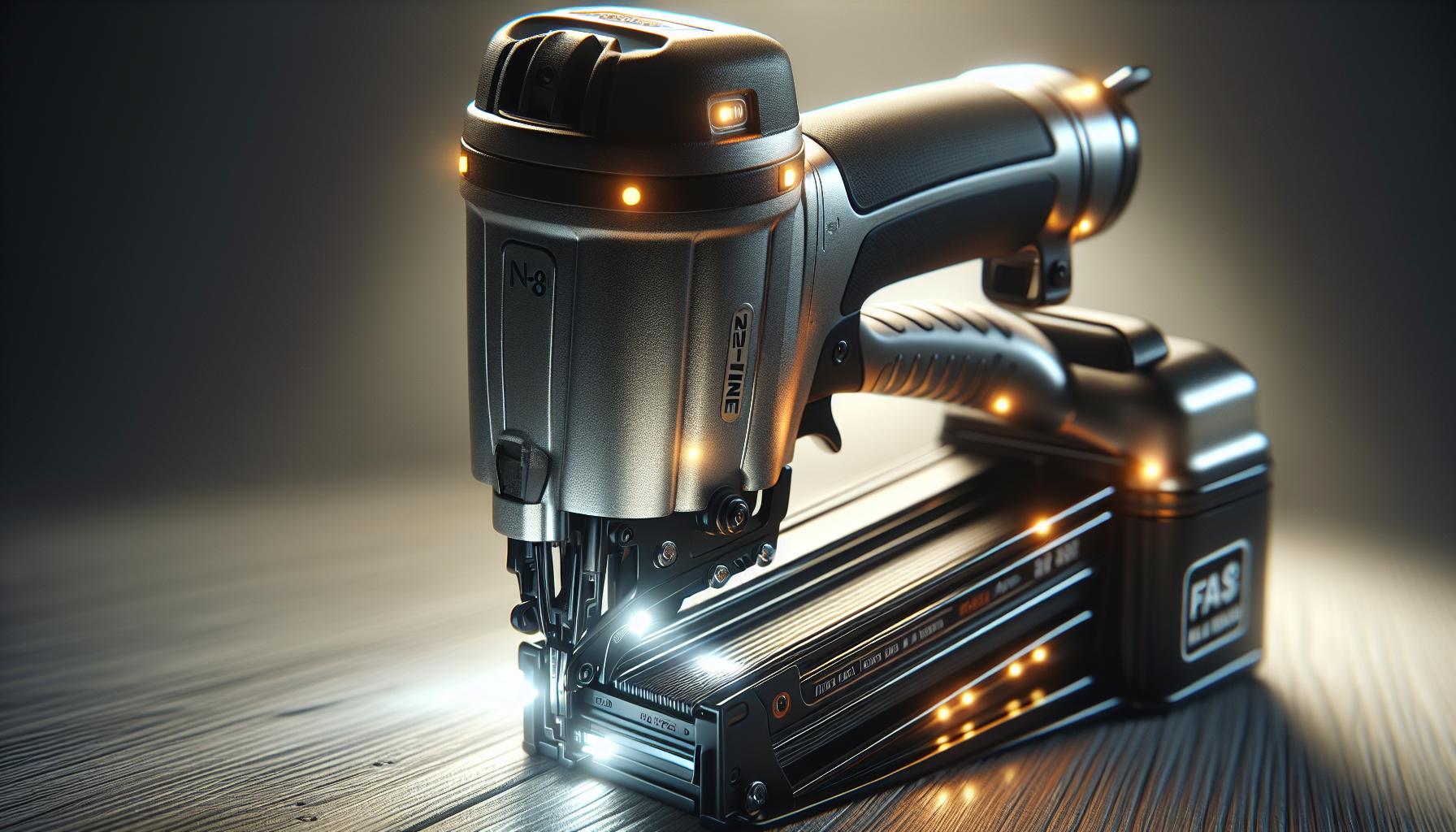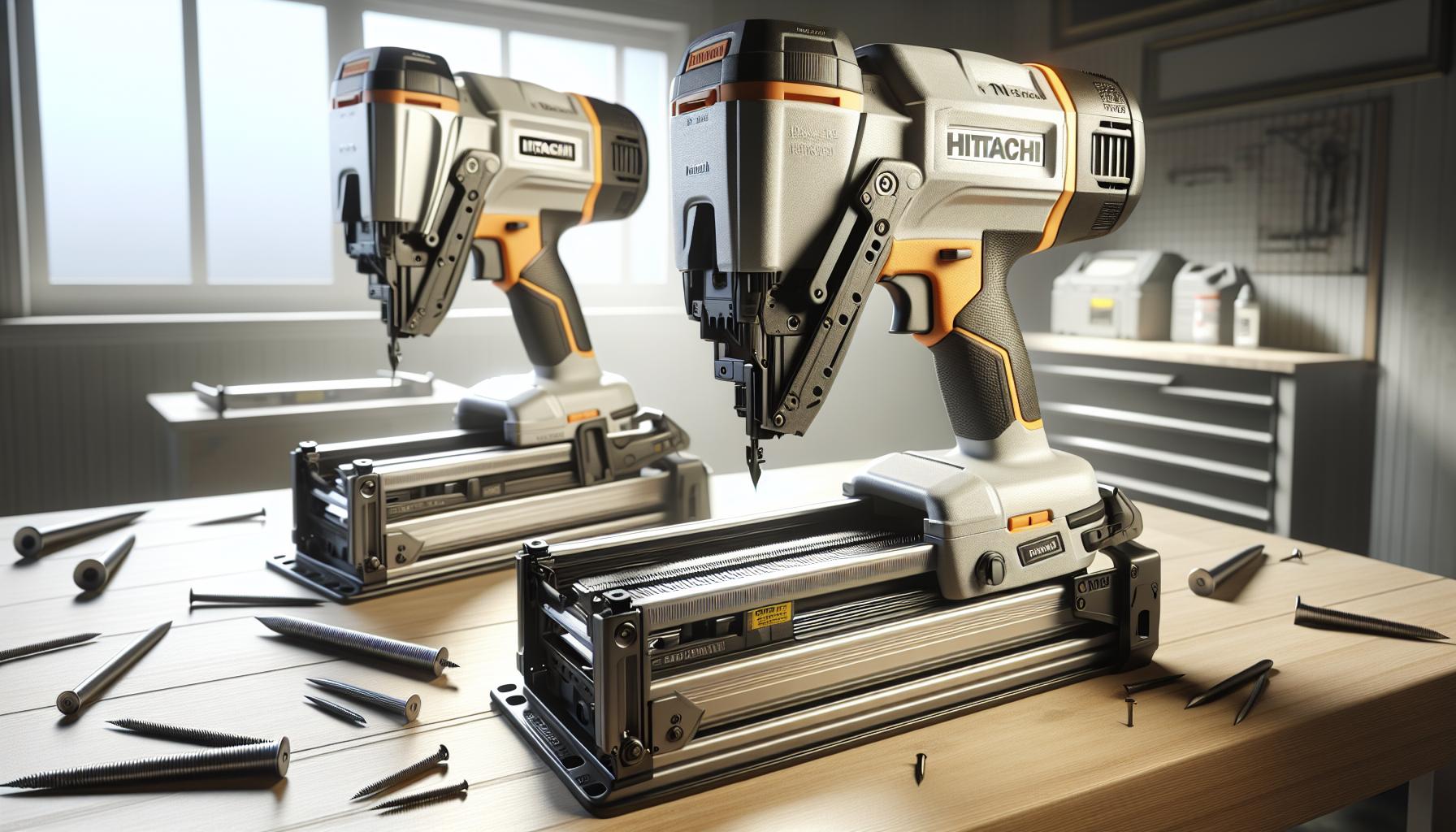When it comes to woodworking and trim projects, a reliable finish nailer is a must-have in your toolkit. I’ve used a wide array of nail guns over the years, but two brands always spark debate among professionals and DIY enthusiasts alike: Hitachi and DeWalt. Both are powerhouses in the tool industry, but when it’s down to the wire, which one takes the crown for the best finish nailer?
I’ll dive into the nitty-gritty of Hitachi vs DeWalt finish nailers, comparing their performance, durability, and features that matter most to users. Whether you’re hanging crown molding or assembling furniture, choosing the right nailer can make all the difference. So let’s get to the bottom of this nail-biting showdown and see which brand nails it.
Performance Comparison
When assessing performance between Hitachi and DeWalt finish nailers, I’m mainly looking at nail driving power, rate of fire, and overall reliability. Both brands offer tools intended to meet the demands of both DIY enthusiasts and professional carpenters, but there are some marked differences worth highlighting.
Hitachi’s legacy in pneumatic technology gives their finish nailers a reputation for consistent driving power. These nailers are known for sinking nails smoothly, even into harder woods. That’s crucial when you’re working on a project where precision is key. What really stands out with Hitachi is their lightweight design, making them easy to manage over extended periods. Less fatigue on the job means you can work longer and with greater accuracy.
DeWalt’s finish nailers, on the other hand, are often praised for their durable build. Given their robustness, DeWalt nailers might be slightly heavier but they’re built to withstand harsh job site conditions. One point where DeWalt shines is its battery-powered models, delivering consistent performance without the need for a compressor. This untethered freedom can be a major plus, especially when working in areas where dragging a hose is impractical.
To provide a clear picture, let’s look at some raw data comparing two of their popular models: the Hitachi NT65MA4 and the DeWalt D51257K.
| Feature | Hitachi NT65MA4 | DeWalt D51257K |
|---|---|---|
| Power Source | Pneumatic | Pneumatic |
| Weight | 4.2 lbs | 3.85 lbs |
| Nail Size Range | 1-1/4″ to 2-1/2″ | 1″ to 2-1/2″ |
| Magazine Capacity | 100 nails | 100 nails |
| Operating Pressure | 70-120 PSI | 70-120 PSI |
Though both finish nailers have similar nail size compatibilities and operating pressures, the weight difference might be influential in choosing between the two depending on user preference and application frequency. Moreover, the inclusion of a tool-free jam release on the DeWalt model adds a layer of convenience during long work sessions, where you might encounter a nail jam.
Durability Assessment
When assessing the durability of finish nailers, we’re talking about how well they withstand the wear and tear of regular use. From my extensive use of nailers in various conditions, I’ve gathered reliable insight into how Hitachi and DeWalt nailers hold up over time.
Hitachi’s finish nailers have a solid track record. With their lightweight magnesium bodies, they resist corrosion and can endure the occasional drop without significant damage. It’s not uncommon for these nailers to last for years under heavy use.
DeWalt, on the other hand, employs robust construction with a focus on tough environments. Their finish nailers feature impact-resistant top caps and integrated rubber skid pads, offering an additional layer of protection. It’s this attention to detail that often sees DeWalt tools passed down from one generation to the next.
Having observed various models in action, one thing’s clear: maintenance plays a pivotal role in a tool’s longevity. Both brands provide clear guidelines on proper care and maintenance. Adherence to these practices is key to maximizing lifespan. For instance, regular oiling and cleaning of air-powered models or proper charging habits for battery-operated units can dramatically impact durability.
Feedback from fellow professionals confirms my observations. In forums and on job sites, I’ve heard numerous accounts of both Hitachi and DeWalt nailers surviving challenging conditions. However, I’ve noted a slight edge for DeWalt in terms of surviving long-term rigorous use.
| Brand | Nailer Type | Notable Durability Features |
|---|---|---|
| Hitachi | Air-powered | Lightweight magnesium construction |
| DeWalt | Air-powered and Battery-operated | Impact-resistant top caps, rubber skid pads |
Remember also that warranty offers can speak volumes about a manufacturer’s confidence in their product’s durability. DeWalt typically offers a three-year limited warranty, while Hitachi may offer different warranty periods depending on where you purchase your tool.
Noteworthy is that while both brands deliver high-grade durability, personal preference in handling, maintenance habits, and the frequency of use will influence the overall resilience of your finish nailer.
Feature Showdown
When deciding between Hitachi and DeWalt finish nailers, it’s crucial to consider the unique features each offers. In this segment, I’ll delve into the specifics that set each brand apart, helping you determine which nailer best fits your needs.
Hitachi finish nailers are famed for their unique air duster. This built-in feature allows users to clear away dust and debris from the work surface with a simple push of a button, ensuring a cleaner nailing area and better finish. Additionally, they often include selective actuation switches. This means you can swiftly switch between sequential and contact nailing without needing additional tools.
On the other hand, DeWalt finish nailers excel with their 20-degree angle magazine, facilitating easier access in tight corners and spaces. This is a game-changer when working on intricate trims. Plus, DeWalt’s nailers usually come with LED lights, providing better visibility in low-light conditions. For professionals or do-it-yourselfers who often find themselves in dimly lit environments, this could be a deciding factor.
Both brands have made impressive strides in creating tools that marry power with precision. However, while DeWalt prides itself on tool-free jam release mechanisms for quick and easy nail removal, Hitachi’s answer to this is their simple flip open nose design, offering a straightforward solution to potential nail jams.
Another point to look out for is the depth of drive adjustment feature. Hitachi nailers often sport an easy-to-use dial with a large range for adjusting nailing depth, perfect for customizing the tool to the task at hand. DeWalt, too, has this feature, but some users may prefer the thumbwheel adjustment for its tactile control.
It’s essential to consider how each of these features lines up with the work you’re planning. Whether it’s the ease of cleaning the work surface, the angular precision required for the task, visibility in the working area, or the convenience of setting and resolving jams, your choice could greatly influence your workflow and productivity.
User-Friendly Design
When I’m selecting a finish nailer, I’m always on the lookout for tools that won’t just get the job done but will make the process as smooth as possible. User-friendly design can significantly reduce fatigue and boost efficiency on the job site. This is where Hitachi and DeWalt have invested considerable thought.
Hitachi finish nailers are renowned for their lightweight design. With many of their models boasting ergonomic grips, they fit comfortably in the hand, dramatically reducing the strain on your arms during a long day’s work. These nailers also feature clear indicators for nail size and an easy-to-use depth-of-drive dial which lets me make quick adjustments without needing extra tools.
Meanwhile, DeWalt’s focus on user-friendly design is evident through their 20-degree angle magazines. This smart design choice allows me to reach tight corners and spaces where a straight nailer might struggle. Besides, DeWalt’s LED lights are a godsend when I’m working in dimly lit spaces. The illumination ensures I can see exactly where I’m nailing without the need for additional lighting.
Both brands have different approaches to making their finish nailers user-friendly, which can be seen in their varying features like:
- DeWalt’s tool-free jam release mechanism
- Hitachi’s selective actuation switch
The tool-free jam release on DeWalt nailers is a resourceful feature that saves time and aggravation on the job. A quick and easy clearing method means I can maintain my workflow without a hitch. Hitachi’s selective actuation switch is equally beneficial, allowing me to switch from single actuation to contact actuation seamlessly. This versatility is crucial when moving between precise finishing work and more rapid nailing needs.
Ergonomics and ease of use are crucial aspects often overlooked when considering the technical specifications of finish nailers. However, my experience has shown that these user-centered designs have a substantial impact on productivity and the overall comfort during extended use. Therefore, when comparing Hitachi and DeWalt, it’s not just about raw performance but also how the design of the nailer enhances practicality and user comfort.
Conclusion
Deciding between Hitachi and DeWalt finish nailers boils down to personal preference and specific needs. Both brands offer durable, user-friendly tools designed to enhance productivity and comfort. Whether you’re swayed by Hitachi’s ergonomic grips and lightweight build or DeWalt’s LED lights and tool-free jam release, you’re investing in a tool that’s built to last. Remember, proper maintenance and taking advantage of warranties will ensure your nailer remains a reliable part of your toolkit for years to come. Choose the one that aligns with your work style and rest assured you’ve made a solid choice.
Frequently Asked Questions
Which brand offers more durable finish nailers, Hitachi or DeWalt?
DeWalt finish nailers are known for their robust construction with impact-resistant top caps and rubber skid pads, whereas Hitachi nailers boast a lightweight magnesium construction. Durability can depend on regular maintenance, but DeWalt additionally provides a three-year limited warranty.
How important is maintenance for the lifespan of finish nailers?
Maintenance is crucial for maximizing the lifespan of finish nailers. Regular cleaning, proper storage, and adherence to the manufacturer’s maintenance recommendations can significantly extend the nailer’s functional life.
What are some user-friendly features of Hitachi finish nailers?
Hitachi finish nailers are designed with the user in mind, featuring a lightweight design and ergonomic grips, as well as a selective actuation switch which allows for easy transition between firing modes.
What user-centered design aspects do DeWalt nailers have?
DeWalt finish nailers incorporate user-centered designs such as 20-degree angle magazines for ease of use in tight spaces and LED lights for improved visibility. They also offer a tool-free jam release mechanism, simplifying nail jam clearances.
Does the angle of the magazine matter for nailers?
Yes, the angle of the magazine can influence the ease of use of the nailer in tight spaces. A 20-degree angle magazine, such as those on DeWalt nailers, allows better access and precision in constricted areas.
Can the design of a nailer affect productivity and user comfort?
Absolutely, features like ergonomic grips, tool-free adjustments, and the weight of the nailer can all impact productivity and user comfort. Both Hitachi and DeWalt have incorporated such features into their finish nailers to enhance overall user experience.



Reader Interactions